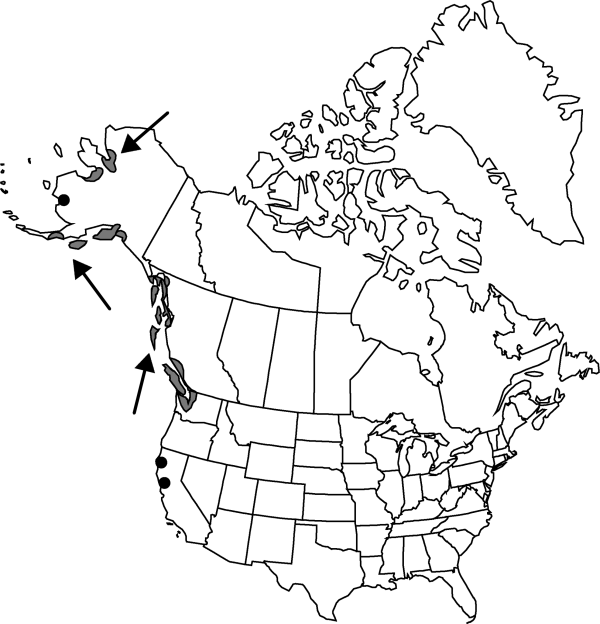Difference between revisions of "Atriplex gmelinii"
Mém. Acad. Imp. Sci. St. Pétersbourg, Sér. 6, Sci. Math. 2: 160. 1838.
FNA>Volume Importer |
FNA>Volume Importer |
||
| Line 17: | Line 17: | ||
}}<!-- | }}<!-- | ||
| − | --><span class="statement" id="st-undefined" data-properties=""><b>Herbs,</b> monoecious, erect or ascending, branched from base or rarely simple, 0.5–8(–100) dm; proximal branches mostly elongated and often prostrate. <b>Leaves</b> alternate, except the proximal-most; petiole 0.5–1.5(–2) cm; blade green on both sides, ovate to oblong or lanceolate to oblong, deltoid-oblong, or linear, 9–100 × 1–50 mm, base mostly rounded to tapering or more rarely broadly cuneate from a hastate base, margin entire or repand denticulate, apex acute or acuminate or more rarely obtuse, glabrous or nearly so. <b>Flowers</b> glomerate in rather loose, spiciform inflorescences, and in axillary clusters; staminate ones 4–5-merous. <b>Fruiting</b> bracteoles darkening at maturity, sessile or stipitate, ovate or oblong to orbiculate, longest ones strap-shaped or ovate-lanceolate, mainly 4–10 mm, distinct nearly to base, margin entire or with (1 or) 2 or more teeth, apex acuminate to acute, often bulging on both sides of the impressed midnerve, at first mealy, finally glabrate. <b>Seeds</b> dimorphic: some small, black (lacking? in <i></i>var.<i> alaskensis</i>), convex, 1.5–2 mm wide, lustrous, others pale brown, flat, 1.5–3.5 mm wide; radicle inferior or subascending. <b>2n</b> = 54.</span><!-- | + | --><span class="statement" id="st-undefined" data-properties=""><b>Herbs,</b> monoecious, erect or ascending, branched from base or rarely simple, 0.5–8(–100) dm; proximal branches mostly elongated and often prostrate. <b>Leaves</b> alternate, except the proximal-most; petiole 0.5–1.5(–2) cm; blade green on both sides, ovate to oblong or lanceolate to oblong, deltoid-oblong, or linear, 9–100 × 1–50 mm, base mostly rounded to tapering or more rarely broadly cuneate from a hastate base, margin entire or repand denticulate, apex acute or acuminate or more rarely obtuse, glabrous or nearly so. <b>Flowers</b> glomerate in rather loose, spiciform inflorescences, and in axillary clusters; staminate ones 4–5-merous. <b>Fruiting</b> bracteoles darkening at maturity, sessile or stipitate, ovate or oblong to orbiculate, longest ones strap-shaped or ovate-lanceolate, mainly 4–10 mm, distinct nearly to base, margin entire or with (1 or) 2 or more teeth, apex acuminate to acute, often bulging on both sides of the impressed midnerve, at first mealy, finally glabrate. <b>Seeds</b> dimorphic: some small, black (lacking? in <i></i></i>var.<i><i> alaskensis</i>), convex, 1.5–2 mm wide, lustrous, others pale brown, flat, 1.5–3.5 mm wide; radicle inferior or subascending. <b>2n</b> = 54.</span><!-- |
-->{{Treatment/Body | -->{{Treatment/Body | ||
| Line 56: | Line 56: | ||
|publication year=1838 | |publication year=1838 | ||
|special status= | |special status= | ||
| − | |source xml=https://jpend@bitbucket.org/aafc-mbb/fna-data-curation.git/src/ | + | |source xml=https://jpend@bitbucket.org/aafc-mbb/fna-data-curation.git/src/f6b125a955440c0872999024f038d74684f65921/coarse_grained_fna_xml/V4/V4_632.xml |
|genus=Atriplex | |genus=Atriplex | ||
|subgenus=Atriplex subg. Atriplex | |subgenus=Atriplex subg. Atriplex | ||
Revision as of 21:01, 24 September 2019
Herbs, monoecious, erect or ascending, branched from base or rarely simple, 0.5–8(–100) dm; proximal branches mostly elongated and often prostrate. Leaves alternate, except the proximal-most; petiole 0.5–1.5(–2) cm; blade green on both sides, ovate to oblong or lanceolate to oblong, deltoid-oblong, or linear, 9–100 × 1–50 mm, base mostly rounded to tapering or more rarely broadly cuneate from a hastate base, margin entire or repand denticulate, apex acute or acuminate or more rarely obtuse, glabrous or nearly so. Flowers glomerate in rather loose, spiciform inflorescences, and in axillary clusters; staminate ones 4–5-merous. Fruiting bracteoles darkening at maturity, sessile or stipitate, ovate or oblong to orbiculate, longest ones strap-shaped or ovate-lanceolate, mainly 4–10 mm, distinct nearly to base, margin entire or with (1 or) 2 or more teeth, apex acuminate to acute, often bulging on both sides of the impressed midnerve, at first mealy, finally glabrate. Seeds dimorphic: some small, black (lacking? in var. alaskensis), convex, 1.5–2 mm wide, lustrous, others pale brown, flat, 1.5–3.5 mm wide; radicle inferior or subascending. 2n = 54.
Distribution

w North America.
Discussion
Varieties 2 (2 in the flora).
Selected References
None.
Key
| 1 | Brown seeds 1.7-3 mm wide; fruiting bracteoles mostly less than 10 mm; leaf blades mainly oblong to lance-oblong or linear, less commonly hastate-lanceolate | Atriplex gmelinii var. gmelinii |
| 1 | Brown seeds 2.8-3.5 mm wide; fruiting bracteoles often more than 10 mm; leaf blades oblong to lanceolate or hastate-lanceolate or -ovate | Atriplex gmelinii var. alaskensis |